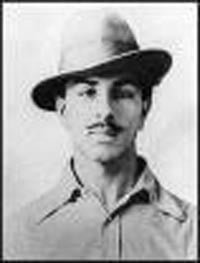
Bhagat Singh (28 Sept., 1907-23 March, 1931) was born into a Jat Sikh family to Sardar Kishan Singh and Vidyavati in Khatkar Kalan village near Banga in the Lyallpur district of Punjab. As a child, he was deeply affected by the Jalianwala Bagh Massacre that took place in Punjab in 1919. When Mahatma Gandhi started the Non-Cooperation Movement in 1920, he became an active participant at the age of 13.
Bhagat Singh studied at the National College, but ran away from home to escape early marriage, and met his fellow revolutionaries. He became a member of the organization Naujawan Bharat Sabha. In the Naujawan Bharat Sabha, Bhagat and his fellow revolutionaries grew popular amongst the youth. He wrote for and edited Urdu and Punjabi newspapers published from Amritsar. In September 1928, a meeting of various revolutionaries from across India was called at Delhi under the banner of the Kirti Kissan Party. Bhagat Singh was the Secretary of the meet. His later revolutionary activities were carried out as a leader of this association.
The British government created a commission under Sir John Simon to report on the current political situation in India in 1928. The Indian political parties boycotted the commission because it did not include a single Indian as its member. When the commission visited Lahore on October 30, 1928, Lala Lajpat Rai led the protest against the commission in a silent march, but the police chief Scott beat Lala Lajpat Rai severely and he succumbed to his injuries later. Bhagat Singh, who was an eyewitness to this event, vowed to take revenge on Scott. He joined with other revolutionaries, Rajguru and Sukhdev, in a plot to kill the police chief. However, in a case of mistaken identity, Bhagat Singh accidentally killed Mr. Saunders, a Deputy Superintendent of Police. He quickly left Lahore to escape the police. He shaved his beard and cut his hair to avoid recognition.
In the face of actions by the revolutionaries, the British government enacted the Defence of India Act to give more power to the police. The purpose of the Act was to combat revolutionaries like Bhagat Singh. The Act was defeated in the council by one vote. However, the Act was then passed under the ordinance that claimed that it was in the best interest of the public. In protest, Bhagat Singh and Batukeshwar Dutt, another revolutionary, planned to explode a bomb in the assembly where the ordinance was going to be passed. On April 8, 1929, Singh and Dutt threw bombs onto the corridors and shouted “Inquilab Zindabad!” (“Long Live the Revolution!”). This was followed by a shower of leaflets stating that it takes a loud voice to make the deaf hear. The bomb neither killed nor injured anyone; Singh and Dutt claimed that this was deliberate on their part, a claim substantiated both by British forensics investigators who found that the bomb was not powerful enough to cause injury, and by the fact that the bomb was thrown away from people. Singh and Dutt gave themselves up for arrest after the bomb. He and Dutt were sentenced to ‘Transportation for Life’ for the bombing on June 12, 1929.
Shortly after his arrest and trial for the Assembly bombing, the British came to know of his involvement in the murder of Mr. Saunders. Bhagat Singh, Rajguru, and Sukhdev were charged with the murder. Bhagat Singh decided to use the court as a tool to publicize his cause for the independence of India. He admitted to the murder and made many anti-British statements during the trial. On March 23, 1931 Bhagat Singh was hanged with his fellow comrades Rajguru and Sukhdev.
